Deer hunting
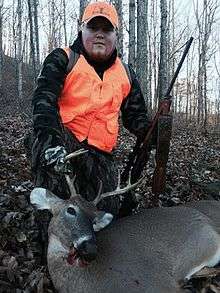
Deer hunting is survival hunting or sport hunting for deer, which dates back tens of thousands of years. There are many types of deer around the world that are hunted.
International practices
New Zealand
New Zealand has had 10 species of deer (Cervidae) introduced. From the 1850s, red deer were liberated, followed by fallow, sambar, wapiti, sika, rusa, and whitetail. The introduced herds of axis and moose failed to grow, and have become extinct. In the absence of predators to control populations, deer were thought to be a pest due to their effect on native vegetation. From the 1950s the government employed professional hunters to cull the deer population. Deer hunting is now a recreational activity, organised and advocated for at the national level by the New Zealand Deerstalkers' Association.[1]
North America


The deer most sought after in North America, east of the Rocky Mountains, is the white-tailed deer. West of the Rockies, the mule deer is the dominant deer species. Blacktail deer are dominant along the west coast (west of the Cascade Range) from Northern California to Southeast Alaska, with introduced populations in Prince William Sound and the Kodiak Archipelago. The most notable differences between these deer, other than distribution, are the differences in ears, tail, antler shape (the way they each fork), and body size. The mule deer's ears are proportionally longer than the ears of a white-tailed deer, they also have different color skin and brighter faces and resemble that of a mule. Mule deer have a black-tipped tail which is proportionally smaller than that of the white-tailed deer. Buck deer of both species sprout antlers; the antlers of the mule deer branch and rebranch forming a series of Y shapes, while white-tailed bucks typically have one main beam with several tines sprouting from it. White-tailed bucks are slightly smaller than mule deer bucks. Both of the species lose their antlers in January, and regrow the antlers during the following summer beginning in June. Velvet from the antlers are shed in August and September. Each buck normally gets larger each year as long as good food sources are present. Antler growth depends on food sources. If food is not good one year, antlers will be smaller. Many deer do not reach their full potential due to getting hit by automobiles, also known as road kills.
In Hawaii, axis deer were introduced into the environment in the 1950s. Having no predators their numbers quickly grew and they are considered an "invasive species" especially on the islands of Lanai and Maui. Recently there have been sightings of axis deer on the big island of Hawaii. Most of the deer hunting on Maui is on privately held lands.
Moose and elk are also popular game animals that are technically species of deer. However, hunting them is not usually referred to as deer hunting, it is called big game hunting. They are considerably larger than mule deer or white-tailed deer, and hunting techniques are rather different.
In Canada and Alaska, reindeer (caribou) are hunted extensively.
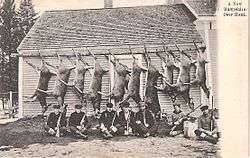

Deer hunting seasons vary across the United States; some seasons in Florida and Kentucky[2] start as early as September and can go all the way until February like in Texas. The government agency such as the DFW (Department of Fish and Wildlife) regulate the durations of these hunting seasons. The length of the season is often based on the health and population of the deer herd, in addition to the number of hunters expected to be participating in the deer hunt. The durations of deer hunting seasons vary from state to state, and can even be different on a county basis within a specific state (as is the case in Kentucky[2]). The DFW will also create specific time frames within the season where the number of hunters able to hunt is limited; this is known as a controlled hunt. The DFW will also create different time periods where you are only allowed to use a specified type of weapon: bows only (compound, recurve, and crossbows), modern firearms (rifles and shotguns) or muzzleloaders. (Note also that some states, such as Kentucky,[2] consider only compound and recurve bows as "bows" for hunting regulation purposes, and have special seasons for crossbows.) For example, during a bows-only season, in many areas you would be limited to the use of a bow and the use of any firearm would be prohibited until that specific season opens, and in some areas a crossbow can only be used during a dedicated season for that weapon. Similarly, during a muzzleloader season, use of modern firearms is almost always prohibited. However, in many states, the archery season (at least for compound and recurve bows) completely overlaps all firearms seasons; in those locations, bowhunters may take deer during a firearms season. Some states also have restrictions on hunting of antlered or antlerless deer. For example, Kentucky allows the taking of antlerless deer during any deer season in most of the state, but in certain areas allows only antlered deer to be taken during parts of deer season.[2]
United Kingdom
There are six species of deer in the UK : red deer, roe deer, fallow deer, Sika deer, Reeves muntjac deer, and Chinese water deer, as well as hybrids of these deer. All are hunted to a degree reflecting their relative population either as sport or for the purposes of culling. Closed seasons for deer vary by species.[3] The practice of declaring a closed season in England dates back to medieval times, when it was called fence month and commonly lasted from June 9 to July 9, though the actual dates varied.[4] It is illegal to use bows to hunt any wild animal in the UK under the Wildlife and Countryside Act 1981.
UK deer stalkers, if supplying venison (in fur) to game dealers, butchers and restaurants, need to hold a Lantra level 2 large game meat hygiene certificate. Courses are run by organisations such as Basc (British association for shooting and conservation) and this qualification is also included within the Level 1 deer stalking certificate. If supplying venison for public consumption (meat), you need to have a fully functioning and clean larder that meets FSA standards and to register as a food business with your local authority.
"Deer stalking" is widely used among British and Irish sportsmen to signify almost all forms of sporting deer shooting, but classically refers to hunting red deer, usually accompanied by a ghillie who knows the estate. This can involve long stretches of crawling across coverlesss moorland to get close enough to the nervous deer to use a rifle. Owners of estates can derive good incomes from charging for the right to hunt and providing a ghillie, especially in the Scottish Highlands. In Europe deer are more often hunted in forests, and payment to the owners is often required. In North American sporting usage "deer hunting" is the term used, and typically involves a small group of hunters in wooded country, without payment. In Britain and Ireland "deer hunting" has historically been reserved exclusively for the sporting pursuit of deer with scent-seeking hounds ("stag hounds"), with unarmed followers typically on horseback.
Australia
In Australia, there are six species of deer that are available to hunt. These are Fallow deer, Sambar, Red deer, Rusa, Chital, and Hog deer.[5]
Deer were first introduced to Australia between 1800 and 1803.[6] All states and territories have populations of deer including many coastal islands. Deer hunting in Australia is mostly practised on the eastern side of the country. Hunting access varies from state-to-state with varying classifications from pest species to game animal with some species afforded the protection of hunting seasons and a requirement for a Game Hunting permit or licence. In New South Wales, the licensing system was previously regulated by the statutory authority Game Council NSW however it is now suspended in that state pending the creation of a new agency. In the states of Queensland and South Australia deer hunting is completely legal with no licence required as deer are classified as a pest species.
The sport is aided by the Australian Deer Association, which handles hunter education, lobbying on behalf of the industry, and maintains the Australian Antlered Trophy Register.
Hunting Methods and Seasons
There are five common methods of hunting. The first method is stand hunting. This is generally the most common method, depending on the terrain. This is done by waiting where deer are likely to travel. Stand hunting is commonly done in an elevated tree stand, but it can be done in a blind on the ground, although hunting blinds are generally on the ground they are often more common to use because it allows more cover for the hunter. Blinds allow the hunter to get away with more movement, as well as blocking the hunter's scent from contaminating the air and alerting the deer. Tree stands are usually placed 8 to 30 feet above the ground. The stands are made of metal or wood. Stands are often placed at the edge of fields of crops such as corn, wheat, buckwheat, alfalfa, clover, soybeans, cotton and many others. Often, hunters plant crops in strategic locations solely for the purpose of attracting deer. Food plots are very effective while hunting deer because deer spend the majority of their time eating getting the nutrients and the fats that they need to survive the winter. without good feeding ground the deer will travel for miles if needed to find good feeding sources. which is why planting food plots for the deer work so well. it keeps the deer close by and improves your chances on harvesting quality deer. This is known as a food plot. Stands are also placed in the woods on the edge of trails that the deer travel on. Some states allow bait to be placed near these stands to attract the deer. This is different from planting a crop. The most common bait is corn.
The second method is commonly known as still hunting: walking along through the woods or along the edge of a field and looking for a deer. The hunter often stops and waits for a few minutes, then moves on and repeats this cycle.
The third method is a deer drive, which consists of flushing deer toward a line of hunters. Hunters form a line and walk through fields or brush towards another line, hoping for a shot or driving the deer toward the other line of hunters. Hunters in the second line may be in tree stands or on the ground. Hunters in lines are a hundred yards to one hundred and fifty yards apart.
The fourth method is known as spot and stalk hunting, which consists of spotting and then stalking in close enough to shoot the deer. Spot and stalk hunting is generally a method of hunting used in places where there are large visible areas, such as mountainous terrain or rolling hills.[7]
The fifth method is known as dog hunting. This method uses dogs to chase the deer. A group of hunters draw numbers out of a hat to determine what "stand" they are going to. The hunter then goes to the number he drew, and hopes the dogs will chase the deer by him. This method of hunting uses shotguns with Buckshot. However, in some states such as Wisconsin, it is illegal to use this method to hunt whitetail deer.
A sixth method, often used by bow hunters, and some gun hunters, during breeding seasons, is to use scents and decoys to draw bucks into range for a successful shot. This can be very effective during the "rut". Hunters use doe in esterous scent to pique a buck's interest and decoys to fix the visual interest of the buck away from the hunter, who is often concealed in a blind or tree stand.[8]
There are other things involved in deer hunting that will result in a successful hunt: A healthy deer herd is one of the most important factors contributing to a successful hunting season.[9] Preparation is important; a hunter will scout areas they plan to hunt several months before the season opens. One way a hunter may scout is by placing a remote camera, commonly referred to as a trail camera or game camera, in locations that show recent deer activity. These cameras, using infrared radiation, take photos when triggered by heat or pre-determined time intervals, and give hunter an idea of what deer may be in the area. Hunters then view camera photos individually or use trail camera photo software[10] to help them pattern specific bucks and decide where to hunt.
They will also plant food plots to bring deer to the area or bait the area with corn or oats. They will build tree stands or make ground blinds. They will sight in rifles to make sure the guns shoot straight. They will make sure they have lures, food, water, and all equipment necessary for hunting. Hunting cabins will be stocked with food and water.
Another method used for hunting which is very important is camouflage. It is designed to break up your human outline so you will not be spotted easily by the animal you may be hunting. Breaking up the human outline and blending in will give you that much more of an advantage on not being spotted by deer which will help you be more successful while hunting.
Methods of pursuing game and corresponding seasons are subject to government regulations, which are determined by each state.
United Kingdom and Republic of Ireland

The vast majority of deer hunted in the UK are stalked. The phrase deer hunting is used to refer (in England and Wales) to the traditional practice of chasing deer with packs of hounds, currently illegal under the Hunting Act 2004.
In the late nineteenth and twentieth centuries, there were several packs of staghounds hunting "carted deer" in England and Ireland. Carted deer were red deer kept in captivity for the sole purpose of being hunted and recaptured alive. More recently, there were three packs of staghounds hunting wild red deer of both sexes on or around Exmoor and the New Forest Buckhounds hunting fallow deer bucks in the New Forest, the latter disbanding in 1997. The practice of hunting with hounds, other than using two hounds to flush deer to be shot by waiting marksmen, has been banned in the UK since 2005; to date, two people have been convicted of breaking the law.[11]
There is one pack of stag hounds in the Republic of Ireland and one in Northern Ireland,[12] the former operating under a licence to hunt carted deer.[13]
Scandinavia
Most of the deer hunting in Scandinavia is by hunters driving the game towards other hunters posted in strategic locations in the terrain, though there is also a fair bit of stalking.
Gallery
-
.png)
A prehistoric cave painting of a deer from Cueva de La Pasiega, Spain.
-

A prehistoric cave painting of Megaloceros from Lascaux, France.
-
.png)
A Neolithic painting of deer hunting from Spain.
-
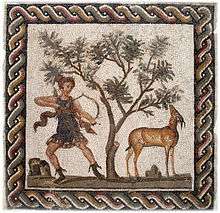
A Roman mosaic depicting the goddess Diana deer hunting.
-
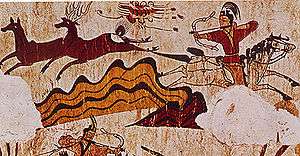
The Goguryeo tomb mural of hunting from Korea.
-
A painting of the goddess Diana deer hunting by Peter Rubens.
-

Theodore Roosevelt in 1885 with his highly decorated deer-skin hunting suit, and Tiffany-carved hunting knife and rifle.
Equipment

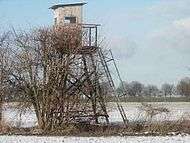

Weapons
Many different weapons are permitted in various states during certain times of deer season. These include bows, crossbows, rifles, shotguns, handguns, and muzzleloaders.
Archery season usually opens before the gun season and may continue for after the gun season has ended. Modern compound bows and recurve bows are used, as well as some longbows. Bows usually have a draw of 35 pounds (15.9 kg) or more. Most hunters use sixty pound (27.2 kg) draw weight with aluminum or carbon fiber arrows although wooden arrows are still used. Crossbows were once more used by disabled hunters who wanted an opportunity to still hunt during archery season. However, in the recent years many states have legalized the use of crossbows for all hunters and thus invite new enthusiasts to take part in the market.
Rifles, shotguns, and pistols are all commonly used for hunting deer. Most regions place limits on the minimum caliber or gauge to be used. Most states require centerfire rifles which is of a caliber larger than .229 in diameter. States that allow shotguns, the minimum gauge is twenty gauge or larger, which includes 16 gauge, 12 gauge and 10 gauge. When hunting with a shotgun, a bullet is used, which is called a shotgun slug. A shotgun slug is a round piece of lead or copper that may or may not have a pointed tip. Its compacted in a paper or plastic shell. Pistols are centerfire which include .357 or .44 magnum. Rimfire rifles of .22 caliber are often prohibited due to the inability of the caliber to kill a deer effectively which brings about ethical concerns.
Muzzleloader hunting is becoming a popular way of hunting with the introduction of many new muzzleloaders that use more practical techniques of reloading shots and appeal to a more broad range of hunters. Most states require that the muzzleloader be a .45 caliber or larger, with .50 caliber being a very popular caliber by means of availability. Muzzleloader hunting has broken itself down into two categories with the use of traditional muzzleloaders and the use of modern muzzleloaders. Traditional involves the use of open sighted rifles, probably with the use of a side locking mechanism that either hammers a cap to ignite the charge or a sparking mechanism known as a flint-lock that sparks and ignites the charge inside the barrel. Ammunition among traditionalists include whole lead shot which may be a ball but bullet shapes have become popular for their accuracy. Powder is measured and poured when doing traditional hunting. Modern muzzleloaders have become advanced in that they are able to perform well alongside some cartridge rifles. CNC machining allows for more accurate barrels. Magnified scopes are normally seen mounted if the state the hunter is in allows the use of scopes on muzzleloaders. Another recent change is that some hunters now use high-pressure smokeless powder in specially-built muzzleloaders instead of low-pressure black powder, requiring less powder to be used and getting a more powerful and accurate shot. Available ammunition now includes saboted rounds consisting of a small-diameter bullet surrounded by a large-diameter sabot which drops away from the bullet as it exits the muzzle. Saboted rounds are usually a copper-jacketed bullet (much like what is used to load cartridge ammunition) encased with a plastic sleeve that seals the barrel for a more powerful and consistent shot than traditional muzzleloader ammunition.
Hunting deer with edged weapons, such as the lance or sword, is still practiced in continental Europe. In such hunts, the hunters are mounted on horseback, and use packs of deerhound or greyhound dogs to track and drive deer.
Tools
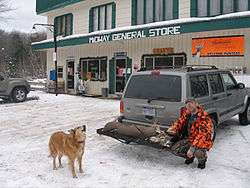
Hunters employ many tools including camouflage clothing, tree stands or blinds of wood or metal, axes, knives, vehicles, chainsaws, deer calls, lures, walkie talkies, cell phones, and handheld GPS units.
Regulations often limit the type of weapons that may be used, as well as accessories and communications devices. For instance, in many cases only calibers beyond a certain size and power may be used, to reduce the chance that the animal will be wounded but not quickly killed. Similarly, hunting with lights, night-vision devices, and radio communications is often restricted. The regulations may vary from season to season and depending on the jurisdiction.
See also
- Big Buck Hunter
- Deer Act 1980 (in the UK)
- Deer farm
- Deer horn
- Deer Hunter - video game
- Deer Avenger - video game
- Deerskin trade
- Reindeer hunting in Greenland
- Venison
- James Jordan Buck
- Hole in the Horn Buck
References
- ↑ http://www.teara.govt.nz/en/hunting/3 Hunting today - Te Ara Encyclopedia of New Zealand
- 1 2 3 4 "Deer Hunting Zones and Seasons". Kentucky Department of Fish & Wildlife Resources. Retrieved January 23, 2015.
- ↑ Naturenet: Shooting, Hunting and Angling Seasons. Naturenet - Countryside Management & Nature Conservation.
- ↑ Forests and Chases of England and Wales: A Glossary. St John's College, Oxford.
- ↑ Game Council NSW
- ↑ Bentley, A (1967), An Introduction to the Deer of Australia.
- ↑ Gegelman, Andrew, Spot and Stalk Hunting - The Lost Art. Nodak Outdoors.
- ↑ http://www.biggamehunt.net/articles/whitetail-finesse-em-or-force-em
- ↑ 1hafc Deer Hunting Advice. Hunting And Fishing In Colorado.
- ↑ "DeerLab". DeerLab Trail Camera Photo Software. October 1, 2013.
- ↑ "Hunting duo appeal is turned down". BBC News. 2007-10-19. Retrieved 2010-05-01.
- ↑ Cassidy, Martin (2005-02-08). "Frustrations of hunter and hunted". BBC News. Retrieved 2010-05-01.
- ↑ Archived November 23, 2007, at the Wayback Machine.